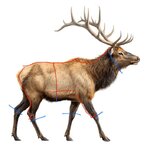HunterGatherer
Lil-Rokslider

For the guys trying to figure out the “dorsal first” method…
I prefer to have the spine uphill, perpendicular to the slope to start if I can get it there. If not, work with whatever God gives ya…
Make the red cuts first starting at the tail. Always cut from inside the hide, never through the hair side. Once the spine cut is made, if you are not saving the cape, make the blue neck cut, right behind the ear.
Now, follow the hairline / color change up the backside of both of the front and hind legs on the topside of the elk. Make a circular cut around the knee joints but wait to make the blue leg cuts until you decide if you want to use the lower leg sections (shanks) for leverage or to tie off. I usually leave them on the top side but cut them off completely on the bottom side before I roll the carcass over to do the second side.
On the front leg, continue the cut that you made up the back of the leg, through the armpit and straight back to the vertical cut in front of the hindquarter. Don’t underestimate the ease of just pulling on the hide with both hands and stripping it down towards the belly once the tight spots on the spine, neck and rump are loose.
Start skinning up the underside of the hindquarter and making cuts up to the ball joint as close to the pelvis as possible. Make a decision now which hind to leave EOS on. I leave a small patch of skin attached to the inside of the hind with the scrotum but I flip it inside out and leave the oysters for the birds.
Make cuts right along the spine to release both front and hind quarters so that when you start making the inside cuts, you finish while cutting from the inside and the quarter comes free easily. Have your game bags already sitting on the peeled ribs and then drop quarters directly into the bags as they come off.
Take the backstrap, tenderloin, organs through the rib cage, and all the neck meat.
Which way you roll it from this point totally depends on the slope, but repeat the same process on the other side.
